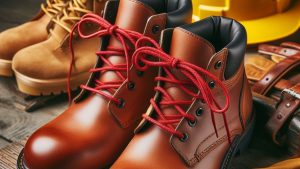1. Criss-Cross Lacing
This is the most common and straightforward method. You start by threading the lace through the bottom set of eyelets, crossing the lace ends and feeding them through the opposite eyelets until you reach the top. It offers a balanced tension across the boot, ensuring a snug fit.
2. Straight Bar Lacing
For those seeking a sleeker look, straight bar lacing is a great option. Instead of crisscrossing the laces, you run them straight across parallel lines, resulting in a cleaner appearance.
3. Army Lacing
This technique provides added ankle support and is great for hikers or anyone looking for extra stability. It involves running the lace diagonally across the eyelets, creating a zigzag pattern that adds firmness to the boot’s hold around your ankle.
4. Gap Lacing
If you have high arches or need extra room around a certain part of your foot, gap lacing might be your solution. This method leaves some space between the eyelets, providing more flexibility in specific areas of the boot.
5. Lock Lacing
To prevent heel slippage or if you have narrow feet, lock lacing can be a game-changer. It involves creating a loop with the laces at the top two eyelets, which tightens as you pull the laces through, locking your heel in place.
Finding Your Perfect Fit
Different lacing patterns serve different purposes, so it’s essential to consider your comfort, foot shape, and the activity you’ll be engaging in. Experimenting with these patterns can not only enhance the look of your boots but also improve their functionality for your unique needs.
Next time you lace up your boots, try one of these techniques and see how it feels. It might just change the way you step out.
Tips for Lacing Your Boots Effectively
Getting the perfect lacing pattern isn’t just about aesthetics; it’s about comfort and functionality. Here’s a deeper dive into optimizing your shoestring hole patterns for various needs:
Consider Your Foot Type
Each lacing pattern can address different foot shapes and issues. For instance, high arches might benefit from gap lacing, while narrow feet might find relief in lock lacing.
Activity Matters
The way you lace up can impact your comfort during various activities. For long walks or hikes, army lacing could offer better ankle support, while straight bar lacing might suit formal occasions.
Tension and Tightness
Adjusting the tension of your laces is key. You want a snug fit without cutting off circulation. Experiment with different levels of tightness until you find what feels right for you.
Heel Slippage
If your heel tends to slip, especially in new boots, try lock lacing. This technique secures your heel in place and prevents uncomfortable movement.
Flexibility and Comfort
Gap lacing provides more flexibility in specific areas of the boot, enhancing comfort for those with unique foot shapes or preferences.
Visual Appeal
Beyond functionality, the way you lace your boots can add a personal touch. Experimenting with different patterns allows you to express your style while ensuring comfort.
Trial and Error
Don’t be afraid to try different lacing techniques. What works for someone else might not work for you. It might take a few tries to find your perfect fit.
Conclusion
Lacing your boots isn’t just a mundane task; it’s an opportunity to fine-tune comfort and style. By exploring these shoestring hole patterns and understanding their nuances, you can elevate both the look and feel of your footwear. Remember, it’s not just about how your boots look; it’s about how they make you feel with every step you take.
Comparison tabular
| Lacing Pattern | Best For | Advantages |
|---|---|---|
| Criss-Cross Lacing | General use, balanced tension | Ensures an even fit across the foot |
| Straight Bar Lacing | Sleeker appearance | Offers a clean and neat visual appeal |
| Army Lacing | Hiking or activities needing ankle support | Provides added stability around the ankle |
| Gap Lacing | High arches or need for flexibility | Allows more room and flexibility in specific areas |
| Lock Lacing | Preventing heel slippage or narrow feet | Locks the heel in place for a secure fit |
This table breaks down each lacing pattern based on the best use case and the advantages it offers. Remember, these are guidelines, and personal comfort should ultimately guide your choice of lacing technique.
Wrapping up
Lacing up your boots isn’t just about functionality; it’s a chance to customize your comfort and style. The various shoestring hole patterns offer unique benefits, from providing stability during a hike to accommodating high arches or narrow feet.
Experimentation is key try out different lacing techniques to discover what works best for you. Whether it’s the classic criss-cross, sleek straight bar, supportive army lacing, flexible gap lacing, or secure lock lacing, each pattern serves a purpose.
Ultimately, the right lacing technique should not only make your boots fit better but also make you feel more comfortable and confident with every step. So, next time you lace up, consider the pattern that suits your needs and enjoy the enhanced experience it brings to your footwear.

Mike the founder of The Shoe String Forum.com, has always had a lifelong love for shoes since he was a kid and with a fervent love for diverse brands like Adidas, Puma, Louis Vuitton, Nike, Birkenstocks, Hey Dudes, Crocs, Vans, Uggs, Converse, and New Balance, he passionately shares extensive footwear research through this platform.
Related Posts
- Are all shoestring eyelets in Work boots functional?
When it comes to your work boots, those little holes where your shoelaces thread through…
- Are all shoestring eyelets in your Hiking boots functional?
When it comes to your hiking boots and those seemingly abundant shoestring holes, it's natural…
- What Are the Various Types of Shoestring Eyelets Found on Cowboy Boots?
Let's delve into the world of cowboy boot eyelets. These small yet pivotal components contribute…

